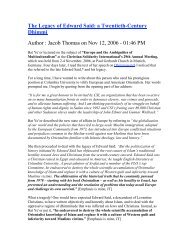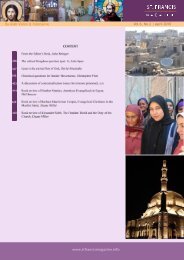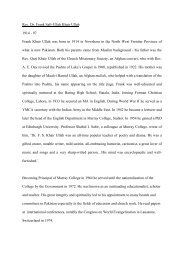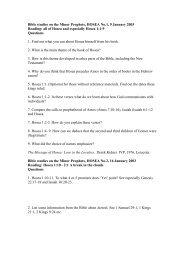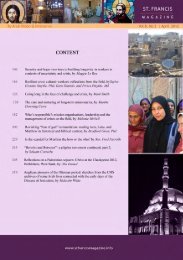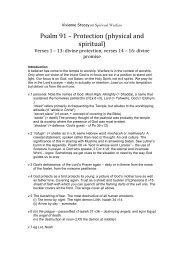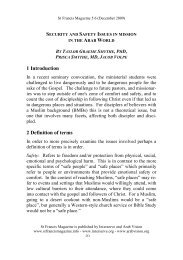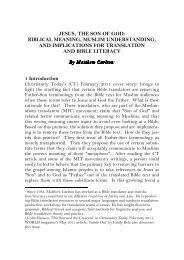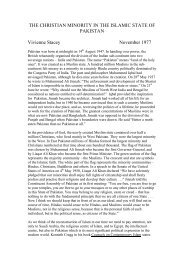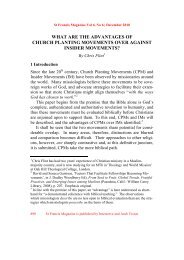download the pdf - St.Francis Magazine
download the pdf - St.Francis Magazine
download the pdf - St.Francis Magazine
You also want an ePaper? Increase the reach of your titles
YUMPU automatically turns print PDFs into web optimized ePapers that Google loves.
<strong>St</strong> <strong>Francis</strong> <strong>Magazine</strong> Vol 8, No 4 | August 2012<br />
On rare occasions, usually triggered by some prevailing political<br />
conflict, forced conversion took place at <strong>the</strong> point of a sword. More<br />
systematic under <strong>the</strong> Ottomans was <strong>the</strong> practice of turning Christian<br />
child-slaves into Muslims to become troops for <strong>the</strong> imperial army.<br />
But when does force become coercion, or coercion become mere<br />
pressure The burden of <strong>the</strong> jizya tax varied under different rulers,<br />
but in some periods became an oppressive burden, from which <strong>the</strong><br />
only means of escape was to convert to Islam and pay zakat instead.<br />
Muslim family law also pervasively fostered a one-way expansion of<br />
Islam, in that it permitted people to marry into <strong>the</strong> Muslim community<br />
but not out of it. Thus, even if those wives <strong>the</strong>mselves did not<br />
convert, <strong>the</strong>ir offspring were automatically counted as Muslim.<br />
Personal conviction certainly played a part in some Christians<br />
converting to Islam. Some were attracted by Islamic apologetics, 82<br />
some by Muslims’ lifestyle and some by <strong>the</strong> Sufis’ claim to offer<br />
blessings and access to God. It seems that Christian populations<br />
turned to Islam more quickly in regions where <strong>the</strong>ir faith was not<br />
firmly rooted in local language and culture; this is one likely reason<br />
why <strong>the</strong> Berber Christians in North Africa, compelled to follow Latin<br />
rites under Roman priests, switched to Islam more quickly than did<br />
<strong>the</strong> Egyptian Copts with <strong>the</strong>ir indigenous leadership and liturgy.<br />
The “stick” of social discrimination for Christians, combined with<br />
<strong>the</strong> “carrot” of social advancement for converts, was ano<strong>the</strong>r factor in<br />
some contexts. Although <strong>the</strong> so-called “Covenant of Umar” with its<br />
heavy discriminatory burden on non-Muslims was not applied uniformly,<br />
yet it reinforced a general sense of dhimmi status. Richard<br />
Fletcher writes of Christians under Arab rule in Spain,<br />
HarperCollins, 2008); also Richard Bulliet, Conversion to Islam in <strong>the</strong> Medieval Period:<br />
An Essay in Quantitative History. (Cambridge, Mass.: Harvard University Press,<br />
1979); N. Levtzion, (ed) Conversion to Islam. (New York and London: Holmes and<br />
Meier, 1979); works by Bat Ye’or, etc.<br />
82 Thus it has been argued that some of <strong>the</strong> Christian apologetics towards Islam in<br />
<strong>the</strong> early Abbasid period was motivated by a desire not so much to draw Muslims to<br />
Christianity as to stem <strong>the</strong> growing haemorrhage of Christians to Islam.<br />
<strong>St</strong> <strong>Francis</strong> <strong>Magazine</strong> is a publication of Interserve and Arab Vision 539




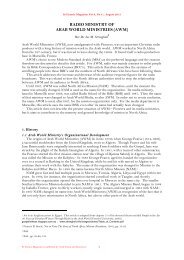
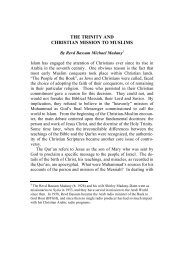
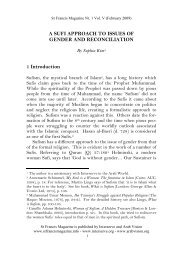
![Reflections on Surah Fatiha and the Lord's Prayer[1] - St.Francis ...](https://img.yumpu.com/49377951/1/184x260/reflections-on-surah-fatiha-and-the-lords-prayer1-stfrancis-.jpg?quality=85)
